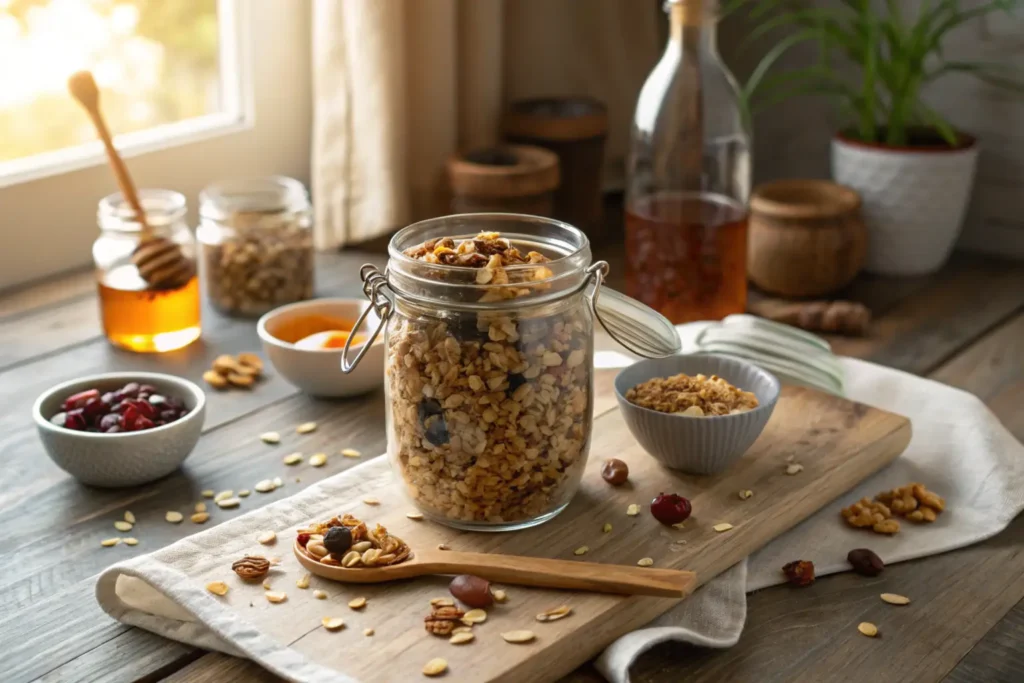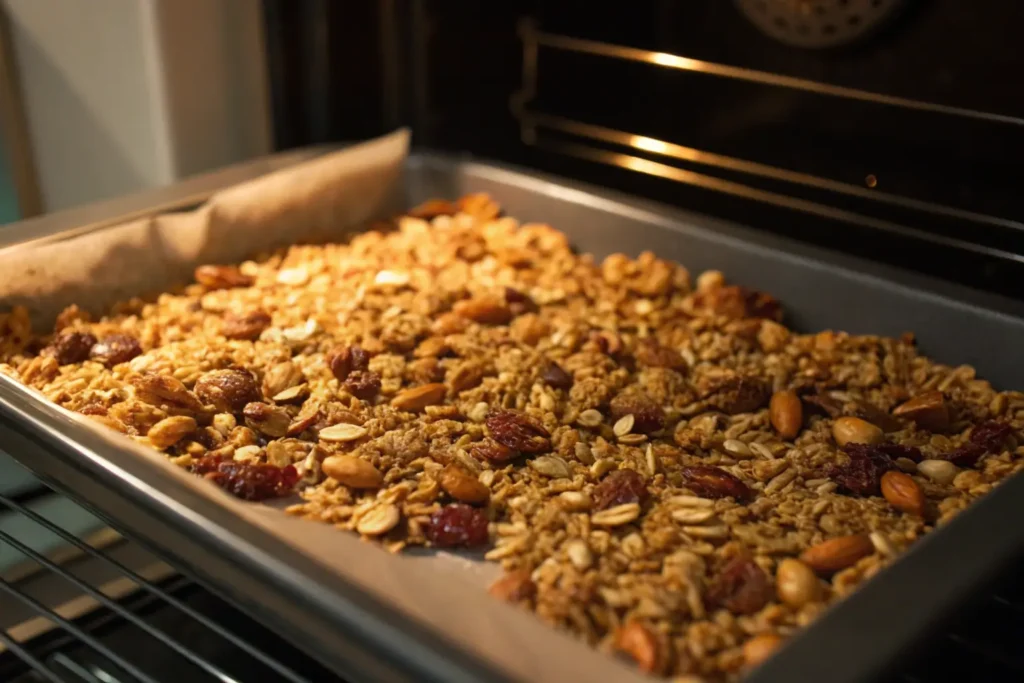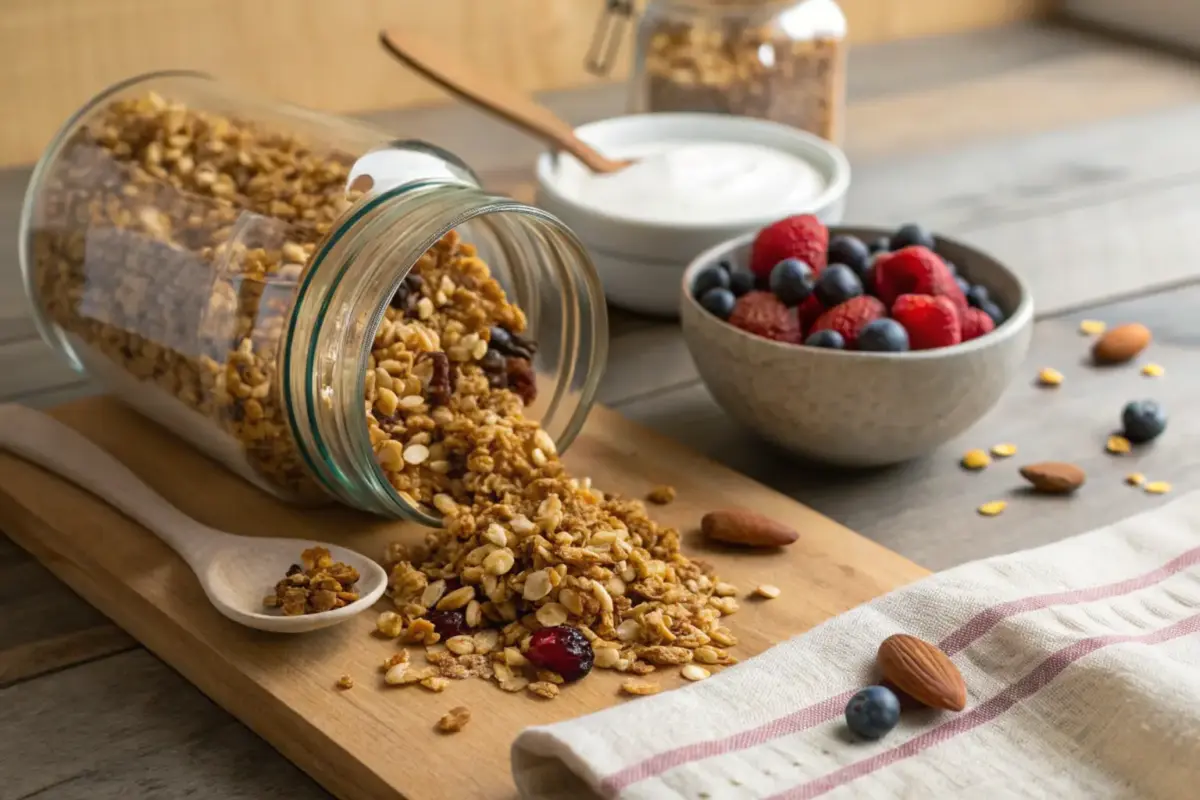Introduction
Homemade granola not crunchy? Oh, I’ve been there—pulling out a tray of golden oats, nuts, and seeds, only to find they’re missing that irresistible snap. Let’s face it, crunchy granola is what dreams are made of. It’s the kind of treat that makes breakfast feel indulgent and snacks totally guilt-free. Without the crunch, it’s just, well, oatmeal in disguise. But here’s the thing—getting it right doesn’t have to be complicated. Whether it’s the ingredients, baking techniques, or how you store it, there are simple tweaks that can make all the difference. Trust me, by the time you’re done reading, you’ll know exactly why your granola isn’t crunchy and how to fix it for good. Grab a spoon, and let’s figure this out together because crunchy granola isn’t just a goal—it’s a necessity for anyone who loves that perfect bite.
The Importance of Crunch in Granola
Crunchy granola isn’t just about texture—it’s about the entire eating experience. The crunch gives it that satisfying bite, making it feel fresh and homemade in the best way. Without it, granola can feel a bit, well, soggy and sad. Plus, the crunch acts as a natural contrast to softer toppings like milk, yogurt, or fresh fruit. Getting this texture right is what separates store-bought quality from your own kitchen masterpiece.
Common Reasons for Soft Homemade Granola
Struggling with homemade granola not crunchy? You’re not alone—this is a common issue, and it usually comes down to a few sneaky missteps. The good news is that each one has an easy fix. Whether it’s too much moisture, rushed baking, or overcrowding your baking sheet, understanding what’s going wrong is the first step toward that perfect crunch. Let’s break it down so your next batch of granola is crispy, golden, and absolutely irresistible.
Excess Moisture in Granola Ingredients
Moisture is one of the main reasons for homemade granola not turning crunchy. Ingredients like dried fruits or fresh coconut can add unexpected moisture, leaving your granola soft. Even improperly stored oats can soak up humidity. To avoid this, use dry, fresh ingredients and keep everything stored in a cool, dry place before baking.
Inadequate Baking Time for Crunchy Granola
Homemade granola not crunchy often happens when it’s pulled out of the oven too soon. It might smell amazing, but if it hasn’t had enough time to dry out, the granola won’t crisp up properly. Always bake until it’s a deep golden brown and then let it cool completely—it hardens as it cools, creating that irresistible crunch.
Incorrect Oven Temperature Ruins Crunchy Granola
If your oven temperature is off, it can cause problems for achieving crunchy granola. Too low, and the granola won’t dry out properly. Too high, and it might burn before it gets the chance to crisp. Stick to a temperature between 300°F and 325°F for the best results. Using an oven thermometer can help ensure accuracy.
Overcrowding the Baking Sheet Leads to Soft Granola
When your granola is piled too high on the baking sheet, it creates steam instead of baking evenly. This can lead to soft, chewy clusters instead of crispy bites. Always spread your granola in a single layer, and if you’re making a big batch, divide it across two sheets to give it plenty of room to crisp up.
Insufficient Sweeteners or Oils
Sufficient sweeteners and oils are crucial for crunchy granola. Sweeteners like honey or maple syrup caramelize during baking, while oils coat the oats to help them toast evenly. Skimping on these can leave your granola dry and soft. Make sure to lightly coat your ingredients for the best crispy, golden results.
Selecting the Right Ingredients for Crunchy Granola

When it comes to crunchy granola, the ingredients you choose play a major role. Sure, it might be tempting to toss in whatever you have on hand, but a little planning can go a long way. The right mix of oats, nuts, seeds, and sweeteners can make all the difference between a ho-hum batch and a crunchy, golden masterpiece. For a twist, try this Vanilla Nut Granola Recipe for a flavorful variation that’s packed with texture and taste.
Choosing Appropriate Oats
Not all oats are created equal, and for granola, rolled oats are your best bet. Their flat shape and larger size make them ideal for absorbing the sweeteners and oils that help with crisping. Instant oats, on the other hand, tend to turn mushy, while steel-cut oats are too hard to achieve the right texture. Stick to the classics, and you’ll be on your way to crunch city.
Incorporating Nuts and Seeds
Nuts and seeds are not just for added flavor—they’re also key players in creating texture. Almonds, walnuts, pecans, and sunflower seeds toast beautifully in the oven, giving your granola that extra bite. Chop them into smaller pieces for even baking, but don’t go too small. You want a mix of textures that’ll make each spoonful feel like a little treasure hunt.
Balancing Sweeteners and Oils
Sweeteners like honey, maple syrup, or brown sugar don’t just add flavor; they also act as binders, helping the oats and other ingredients stick together and crisp up. If you’re curious about what makes granola hold its shape, check out this guide on What Ingredient Makes Granola Stick Together. Oils like coconut or canola coat the oats, ensuring a golden-brown finish. Getting the balance right is key—too little, and your granola might stay dry and soft; too much, and it can turn greasy or overly sweet.
Optimal Baking Techniques

Even with the perfect ingredients, your granola’s crunchiness depends on how you bake it. A few tweaks to your baking method can take your recipe from good to absolutely crave-worthy. Let’s get into the techniques that’ll bring out the best in your granola.
Setting the Correct Oven Temperature
Baking granola is all about finding that sweet spot in your oven temperature. Around 300°F to 325°F is ideal. At this range, your granola gets enough time to dry out and crisp up without burning. Higher temperatures can caramelize the sugars too quickly, leaving the inside soft. Check your oven’s accuracy with a thermometer if you’re not sure—it makes a world of difference.
Ensuring Even Spreading on the Baking Sheet
When spreading your granola on the baking sheet, go for a single, even layer. Clumping it all together might save space, but it’s not doing your granola any favors. Overlapping pieces prevent air circulation, which means uneven baking. Use a wide, rimmed sheet and take a few extra seconds to spread everything out nicely. Trust me, it’s worth it.
Stirring Frequency During Baking
Now, here’s where opinions can differ. Some folks swear by stirring the granola every 10 to 15 minutes, while others prefer to let it bake undisturbed for larger clumps. Both methods work, but if you’re aiming for even crunchiness, a gentle stir halfway through baking is a safe bet. Just be careful not to overdo it—you don’t want to break up all the clusters.
Allowing Proper Cooling Time
This might be the hardest part—waiting. Once your granola comes out of the oven, let it cool completely before transferring it to a container. As it cools, it hardens and develops that coveted crunch. Move it too soon, and you’ll miss out on the best part. So, grab a cup of coffee or tidy up your kitchen while you wait. Patience pays off here.
Storage Practices to Maintain Crunchiness
Keeping your granola crunchy long after it’s baked is all about proper storage. Once you’ve mastered the perfect batch, the last thing you want is for it to turn soft or stale. Homemade granola not crunchy over time usually happens because of exposure to air, moisture, or improper handling. Let’s dive into the best storage practices to keep your granola as crispy as the day you made it.
Using Airtight Containers
An airtight container is essential for preserving your granola’s crunch. Exposure to air makes granola lose its crispness, so seal it up tightly in glass jars or high-quality plastic containers. If you’re reusing an old container, make sure it’s completely dry and odor-free before filling it with your granola. Allow the granola to cool fully before sealing to avoid trapping moisture inside.
Avoiding Humid Environments
Humidity is the enemy of crunchy granola. If you live in a humid area, consider storing your granola in the refrigerator or freezer. These cool, dry spaces help maintain texture without affecting flavor. Just let the granola sit at room temperature for a few minutes before eating—it’ll stay crisp and delicious.
Keeping Portions Fresh
If you’re not planning to eat the granola right away, store smaller portions in separate containers. This minimizes how often the main container is opened, reducing exposure to air and moisture. Following these simple steps ensures your granola stays crunchy and ready to enjoy, whether it’s breakfast time or snack o’clock.
FAQs
How to keep homemade granola crunchy?
To keep homemade granola crunchy, store it in an airtight container in a cool, dry place. Make sure it’s fully cooled before sealing it to avoid trapping moisture. If you’re in a humid area, refrigerating or freezing your granola can also help maintain its texture. Always reseal the container tightly after each use.
Why is my homemade granola soft?
Soft homemade granola is often the result of too much moisture or not enough baking time. Ingredients like dried fruit or improperly stored oats can introduce moisture, while pulling the granola out of the oven too early prevents it from crisping. Spreading the granola evenly and baking at the right temperature can help resolve this issue.
Why is my granola not getting crunchy?
Granola that doesn’t get crunchy usually suffers from improper baking techniques. The oven temperature might be too low, or the granola might be overcrowded on the baking sheet, preventing even drying. Using enough sweeteners and oils also plays a role in achieving that crispy texture. Letting the granola cool completely after baking is another important step for ensuring crunchiness.
How do you harden homemade granola?
If your granola isn’t as hard as you’d like, try returning it to the oven at a low temperature (around 250°F) for another 10 to 15 minutes. Spread it out evenly on the baking sheet and keep an eye on it to avoid burning. Allow it to cool completely after removing it from the oven, as granola hardens as it cools.
Conclusion
Crunchy granola is more than just a recipe; it’s a labor of love, and every crispy bite proves it. If your homemade granola isn’t crunchy, don’t worry—you’re just a few tweaks away from the batch of your dreams. By selecting the right ingredients, perfecting your baking methods, and following smart storage practices, you can ensure every spoonful delivers the crunch you crave. Remember, patience is key, especially when it comes to baking and cooling. And hey, even if you stumble along the way, that’s part of the fun. Homemade granola is all about experimenting until you find your perfect formula. So don’t give up on that crunch—it’s totally worth it. Whether it’s topping your yogurt or munching straight from the jar, crunchy granola makes life just a little sweeter (and crunchier) every single day.


2 thoughts on “Why Are Homemade Granola Not Crunchy? : Simple Fixes for Perfect Results”